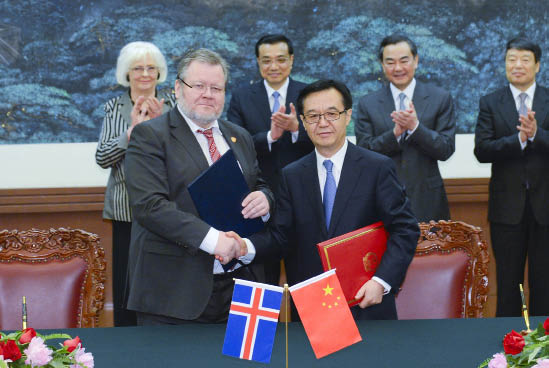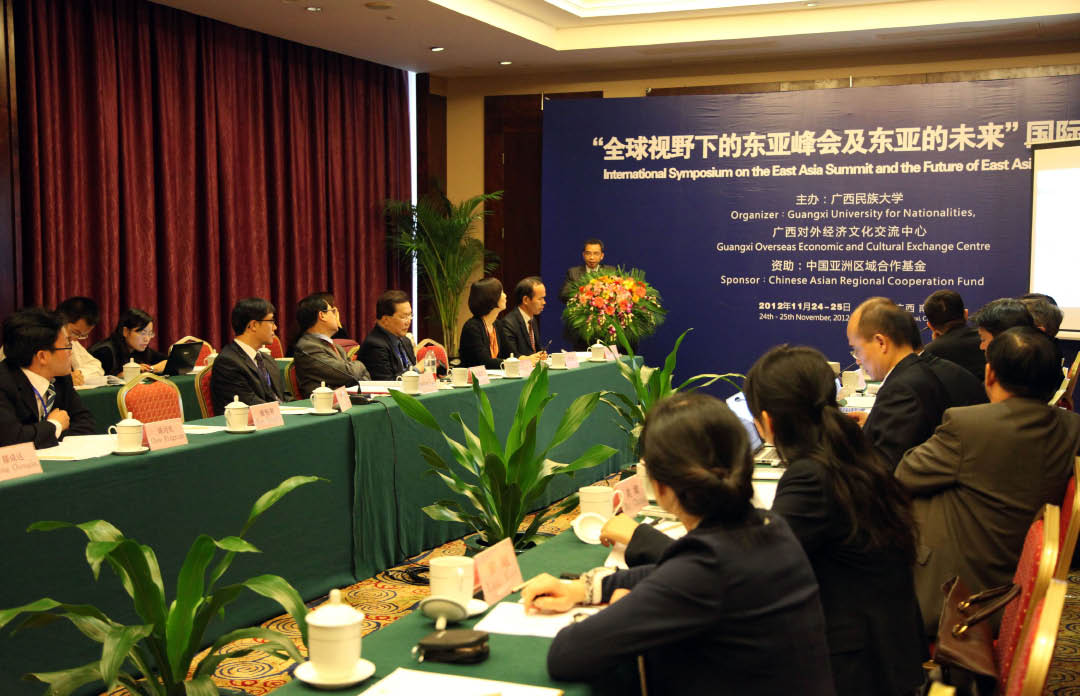China to Accelerate Building of Free Trade Areas
By LU GUOZHENG
PROTECTIONIST sentiment has been on the rise worldwide ever since the last financial crisis. By erecting barriers that stymie the flow of goods and services between nations, protectionist policies actually exacerbate economic misfortune — exactly what the world doesn’t need right now.
Inter-bloc trade frictions have also become more apparent in the last five years. One response China has taken when faced with this reality has been to push for greater regional cooperation in the form of bilateral free trade agreements. Bilateral trade relationships are more easily managed and are a reliable means of consolidating the achievements of the liberalized global trade environment, enhancing economic development and providing economic security to the parties involved.
The world has entered a third wave of post-World War II global free trade development. As a consistent promoter of global free trade, China is putting much energy into building free trade areas. Recent achievements epitomize these efforts.

Chinese Premier Li Keqiang and Icelandic PM Jóhanna Sigurzardóttir at the signing of a free trade pact between the two countries by China's Minister of Commerce Gao Hucheng and Icelandic Minister for Foreign Affairs and External Trade Ӧssur Skarphéðinsson on April 15, 2013.
A Milestone
On April 15, China and Iceland signed a free trade agreement (FTA) in Beijing. After six years of negotiations, Iceland became the first European country to enter into an FTA with China. The agreement and the great benefits it will bring mark a breakthrough that is likely to lend strong impetus to China’s FTA talks with other European nations.
The China-Iceland FTA covers trade in goods and services, investment, and other areas of the economy.
According to the agreement, all Chinese industrial and aquatic products exported to Iceland — 99.77 percent of China’s total export volume to the Nordic country — will be subject to zero-rated customs duties on arrival. Meanwhile, China will impose zero tariff rates on 7,830 former tariff items imported from Iceland, representing 81.56 percent of total import volume. Among the items included are Icelandic aquatic products, a staple of the country’s economy. Following the establishment of a China-Iceland Free Trade Area, nearly 100 percent of the trade volume between the two countries will be duty free.
The parties also made commitments in service trades that are stricter than comparable WTO commitments. Specific provisions on investment, the flow of citizens, sanitary and phytosanitary measures, technical trade barriers, rules of origin, customs procedures, competition policies and intellectual property are also included in the FTA.
FTA Background
China started looking seriously at free trade areas after the 1997 Asian financial crisis. In November 2000, the country initiated FTA negotiations with the Association of Southeast Asian Nations (ASEAN). Negotiations were concluded in November 2004; an agreement was hashed out and the country’s first ever FTA signed. Subsequently the trade volume between China and ASEAN has skyrocketed, exceeding US $400 billion in 2012, US $250 billion more than that between China and Latin America.
In June 2003, the country’s central government signed a Closer Economic Partnership Agreement (a preferential trade agreement similar to an FTA) with both its Hong Kong and Macao special administrative regions. The agreement came into effect on January 1, 2004.
Negotiations on a China-Chile FTA started in November 2004 and were concluded in one year. The subsequent FTA came into effect in October 2006.
During the negotiation and implementation of the above FTAs, China gained valuable negotiating experience, and made significant progress in forwarding its relationship with economic partners around the world.
Currently, China has FTAs with 12 countries and regions in Asia, Latin America, Oceania and Europe. Meanwhile, discussions on building free trade areas with trade partners in Africa, Europe, Latin America, Oceania and Middle East are under way.
National Strategy
After an initial run of success in establishing free trade areas, China came up with its “Free Trade Area Strategy” in 2007. The aim of the strategy is to further reform and opening-up, strengthen relations between trade partners, fight new instances of trade protectionism, and promote the liberalization of world trade and investment and the establishment of global multilateral trade mechanisms.
According to statistics from the World Trade Organization (WTO), a total of 160 regional trade agreements were reported and validated between 2001 and 2012, most of which were free trade agreements. The rush on trade agreements began in the wake of the Asian financial crisis and reached its apogee during the global economic crisis triggered by U.S. sub-prime lending. The year 2008 saw the implementation of 17 regional trade agreements, while 2009 saw 19.
The WTO estimates that regional economic cooperation is poised for more growth in the coming years. This indicates that China’s strategies for building free trade areas conform to trends in the development of world trade and will help facilitate economic recovery in both the Asia-Pacific and beyond.
In the past, developed nations such as the United States and Japan attached great importance to building multilateral or global trade relations. But they failed to pay much attention to regional trade cooperation. Since the beginning of the 21st century, they have realized the oversight and started to readjust their trade development strategies towards regional trade cooperation. The United States has held negotiations and reached free trade agreements with many Latin American and Asian countries in recent years. The U.S.’s efforts have paid off in the form of 14 regional trade agreements, most of which are free trade agreements. Meanwhile, Japan is accelerating its FTA negotiations and has made 13 agreements effective, while the EU has so far validated as many as 35 regional trade agreements.
“Great Game”
Regional trade cooperation has to some extent become a great game played among big powers. The stakes couldn’t be higher.
The United States entered into negotiations for the Trans-Pacific Partnership (TPP) in November 2009 as part of its strategy of returning to Asia. The TPP, however, has not been without controversy. The U.S.-led “high-standard free trade agreement” is seen as a potential substitute for the sputtering Doha round of trade negotiations. It’s also a fairly transparent attempt to contain China’s rise and undermine the positive role ASEAN has played in East Asian economic integration.
Moreover, both the United States and the EU are eager to launch negotiations on a U.S.-Europe free trade agreement, which would create the world’s largest free trade areas and consequently marginalize the WTO’s role in global trade and investment.
Meanwhile, major progress has been made on economic integration in the Asia-Pacific region. At the 7th East Asia Summit (EAS) held in Phnom Penh on November 20, 2012, 10 members of ASEAN, together with China and five other Asia-Pacific countries, announced the launch of talks on a Regional Comprehensive Economic Partnership (RCEP), slated to conclude by the end of 2015. It has the potential to be another “super free trade area,” if the trans-Atlantic EU and North American Free Trade Area is realized. The 16 countries set to be included in RCEP represent a combined market of over three billion people and a GDP of around US $19.78 trillion based on 2011 figures, fully one third of global GDP.
U.S. officials have expressed no concern about the potential for the TPP and RCEP to coexist, saying the Pacific is vast enough to accommodate the two schemes. But the situation may not be that straightforward. The United States’ “return to Asia” has definitely contributed to instability in the region and has drawn attention to issues of contention. More studies need to be done on the potential for the TPP and RCEP to operate side by side.

Scholars from China, Russia, South Korea, Thailand, Vietnam, Malaysia and other countries and regions attended the International Symposium on the East Asia Summit and the Future of East Asia under Global Vision held in Guangxi last November.
Opportunities
The most recent world financial crisis exposed economic weaknesses in many countries, and China was no exception. Thirty years after the country first instituted its reform and opening-up policy, China’s economy has performed remarkably well. But stellar economic growth in the future is not guaranteed. Reform is hard at the best of times; it is harder when the economy is slowing, as it is in China at present. Nevertheless, the country is pushing ahead with industrial reforms and countrywide initiatives to promote sustainable development.
China reaffirmed its commitment to beefing up the building of free trade areas in October 2012. It is set to both seize the opportunities that arise from free trade between nations, and continue in its role as a champion of economic integration.
The reaffirmation also fulfills practical needs. While China has made significant progress in building free trade areas with other countries and territories to date, there’s much more to be done. It is also high time to pack up negotiations that have been running for years and make further improvements to sub-standard and incomplete agreements concluded in the past. Moreover, the overall distribution of China’s free trade areas is far from ideal; more FTA negotiations, especially with developed economies and emerging economies, need to be launched as soon as both sides are willing to sit down at the negotiating table.
We are living in an age of opportunity for free trade. The world is a big place; all countries need to work together to connect it.
LU GUOZHENG is a council member at the International Trade Association of China and the Latin American Society of China, and a part-time researcher at the China-ASEAN Research Institute of Guangxi University.

